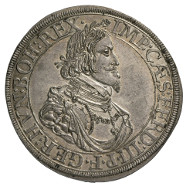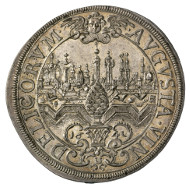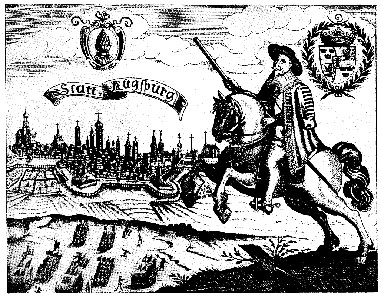courtesy of the MoneyMuseum, Zurich
translated by Teresa Teklic
Why was the human head the motif on coins for centuries, no, for millennia? And why did that change in the last 200 years? Ursula Kampmann is looking for answers to these questions in her book “Menschengesichter” (“Human faces”), from which the texts in this series are taken.
Free Imperial City Augsburg. Taler, 1641. Armoured and draped bust of Emperor Ferdinand III of Habsburg (1637-1657) to the right, around his neck the chain of the Order of the Golden Fleece. Rv. Cityscape of Augsburg, in the foreground city fortifications, in the very foreground the city’s coat of arms with pine cone framed by cartouche. © MoneyMuseum, Zurich.
Augsburg enjoyed the status of a Free Imperial City, a fact that its citizens proudly celebrated by putting Emperor Ferdinand III, their immediate legal superior, on the obverse of this coinage.
This, however, was not always to the city’s advantage. Especially during the Thirty Years’ War it became evident that the free imperial cities were suffering more than others as no territorial prince felt responsible to aid or protect them. The city’s financial reserves were swallowed up by the inflation of 1622/23. And during the famine years 1627–29, no one sent corn or supplies.
Gustav II Adolf, King of Sweden, before the city walls of Augsburg in 1632. Source: Wikicommons.
Like other free imperial cities, Augsburg too was suffering more severely than other cities, who received support from their rulers. The Swedish took the city in 1632 and exhausted the citizens’ last financial resources by means of contributions during their brutal siege, which lasted several months. Just to give you an impression: To cover their pay, the besiegers demanded 7,000 to 8,000 gulden a month from the City of Augsburg, which, by then, was completely exhausted financially, and only had a tax revenue of 300 gulden at the time. In the winter of 1634/35 the Swedish were driven away by Imperial troops, the war moved on, the citizens were momentarily relieved. But how fortunate was their situation really?
What the financial consequences of all this were can be gathered from the following tax records, which provide information about Augsburg’s wealth at the beginning and at the end of the Thirty Years’ War:
| Taxation level | Share of population in 1618 | Share of the population in 1646 |
| “Habnit” (“have-not”) | 48.5 % | 37.2 % |
| 1-15 kreuzer | 13.2 % | 4.2 % |
| 16-30 kreuzer | 7.0 % | 22.0 % |
| 1-10 gulden | 16.5 % | 18.0 % |
| 10-100 gulden | 6.6 % | 5.7 % |
| up to 500 gulden | 1.35 % | 0.5 % |
| more than 500 gulden | 0.01 % | – |
The war had pretty much done away with the “ultra-rich”. In 1618, 128 citizens paid more than 100 gulden in taxes, the number went down to just 20 after the war. Assets had melted due to the many cost allocations that were made in order to satisfy all demands which could not be covered by state funds. On the other hand, the percentage of the have-nots and common people had shrunk as well. Not because they had come into money but because the number of victims among them was particularly high. Of the poorest 5392 households registered for taxes in 1618, no more than 1746 still existed in 1646.
The only “winner” was the middle class – that is, if you consider mere survival a victory.
The focus of our next episode will be the political and military aptitude of Albrecht von Wallenstein, the legendary military leader who earned a fortune – and a title – during the long years of suffering of the Thirty Years’ War.
You can find all episodes in the series here.
A German edition of the book “Menschengesichter” is available in print and as ebook on the site of the Conzett Verlag.






